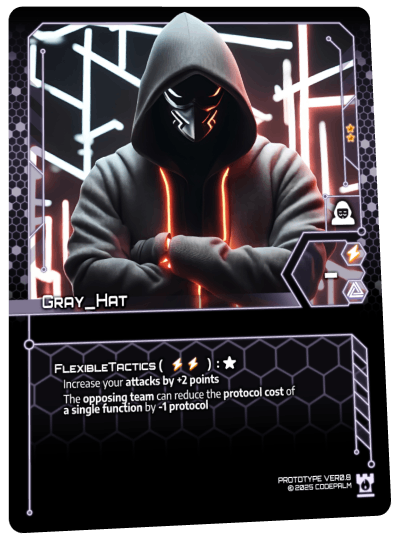¶ Gray_Hat
¶ 🧬 Card Details
 |
|
¶ ⚙️ Function
FlexibleTactics(onSupport): Insrease your attacks by +2 points
The opposing team can reduce the protocol cost of a single function by -1 protocol
How the card works:
- Use Gray_Hat as a double-edged support during preparation or attack rounds
- You get a solid power boost for your Exploit-based strategy
- The enemy gains a small tactical bonus, which they must use wisely — it encourages mutual escalation
¶ ♻️ Strategy
- Best used in fast, aggressive decks that rely on many small advantages
- Combines well with low-cost Exploits, letting you stretch limited resources
- Ideal for high-pressure builds: you win more from the +2 than they gain from -1 cost
- May backfire slightly if opponent uses high-cost Actions, so timing is critical
- The card represents the "gray" balance between risk and gain — fitting thematically
¶ 🛠️ Technical Background
¶ 🧩 Definition
Gray Hat Hackers operate between ethical and unethical behavior. They may access systems without permission — like Black Hats — but do not always do so with harmful intent, like White Hats.
¶ ⚙️ How It Works
They often identify vulnerabilities in systems without authorization, but instead of exploiting them for personal gain, they might report them — sometimes after demonstrating their ability to breach security.
¶ 🔎 Examples
- A hacker who breaks into a government server to expose a vulnerability but doesn't steal data.
- Ethical hackers who test systems without contracts, then demand compensation for disclosure.
- Groups like LulzSec or some
Anonymousoffshoots walk the line between activism and illegal intrusion.
¶ ⚠️ Risks / Importance
Gray Hats challenge legal and ethical boundaries. Their intent may be noble, but their methods often violate the law. Some believe they provide a valuable service; others argue they’re unpredictable and risky.
¶ 🧠 Trivia
- The name Gray Hat is inspired by cowboy culture (White Hat = hero, Black Hat = villain, Gray Hat = morally ambiguous).
- Their real-world equivalents are often found in hacktivist groups or cybersecurity communities.
- The mechanic of giving both sides a benefit symbolizes their blurred role in cyberconflict.
- The Protocol Electric fits well, reflecting impulsive and high-risk behavior.